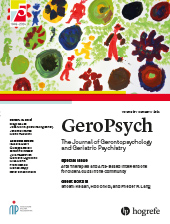Religiousness and Survival in the Swiss Interdisciplinary Longitudinal Study on the Oldest Old
Abstract
Survival in old age has been shown to be positively related to religiousness, and in particular to to church attendance. This research provides new confirmation of this relationship under the Swiss Interdisciplinary Longitudinal Study on the Oldest Old (N = 340 at baseline), a study following subjects aged 80 to 84 at baseline since 1994. Results of logistic regression analyses indicate that participation in church services or a composite measure of religiousness comprising participation in services and the frequency of prayer is positively related to survival in a time interval of 12 to 18 months, controlling for other possible explanatory factors such as functional health or depressive symptoms. To our knowledge, this is the first time that this effect has been demonstrated in a population of old old subjects and in a Latin country of Europe where the number of Catholic subjects is high.
Religiosität und besonders religiöse Aktivitäten wie beispielsweise Gottesdienstbesuche scheinen bisherigen Forschungsergebnissen zufolge in positiver Beziehung zur Langlebigkeit und Überlebenswahrscheinlichkeit im hohen Alter zu stehen. Neuere Befunde zur Relation zwischen Religiosität und Mortalität stammen aus der Schweizer Interdisziplinären Längsschnittsstudie zum hohen Alter (N = 340 zum ersten Messzeitpunkt), in der 80- bis 84jährige seit 1994 regelmäßig befragt wurden. In den Analyzen wurden drei Maße der Religiosität verwendet: die Häufigkeit zu beten, die Häufigkeit der Gottesdienstbesuche sowie ein Religiositätsindikator, der diese beiden Maße zusammenfasste. Die Ergebnisse logistischer Regressionen weisen darauf hin, dass die Teilnahme an Gottesdiensten sowie der Religiositätsindikator in positivem Zusammenhang zur Überlebenswahrscheinlichkeit 12 bis 18 Monate später stehen. Diese Befunde blieben auch nach Kontrolle anderer möglicher Einflussfaktoren wie funktionaler Gesundheit und depressiven Symptomen stabil. Unseren Wissens nach konnte die Beziehung zwischen Religiosität und Überlebenswahrscheinlichkeit damit zum ersten Mal (1) für die Population der alten Alten und (2) für ein europäisches Land mit einem bedeutenden Anteil an katholischer Bevölkerung nachgewiesen werden.
References
(1999). Multilevel and systemic analyses of old age: Theoretical and empirical evidence for a fourth age.. In V.L. Bengtson & K.W. Schaie (Eds.), Handbook of theories of aging (pp.153-173). New York: Springer Publishing Company.
(1999). Multidimensional measurement of religiousness/spirituality for use in health research. . Kalamazoo, MI: John E. Fetzer Institute.
(1993). Factors predictive of long-term coronary heart disease mortality among 10,059 male Israeli civil servants and municipal employees.. Cardiology, 82, 100– 121
(2000). Does private religious activity prolong survival? A six-year follow-up study of 3851 older adults.. Journal of Gerontology: Medical Sciences, 55A, 400– 405
(1999). Religious involvement and U.S. adult mortality.. Demography, 36, 273– 285
(1997a). Religion among disabled and nondisabled persons II: Attendance at religious services as a predictor of the course of disability.. Journal of Gerontology: Social Sciences, 52B(6), 306– 316
(1997b). Religion among disabled and nondisabled persons I: Cross-sectional patterns in health practices, social activities, and well-being.. Journal of Gerontology: Social Sciences, 52B(6), 294– 305
(1996). Does religious observance promote health? Mortality in secular vs. religious kibbutzim in Israel.. American Journal of Public Health, 86, 341– 346
(1997). Religion, psychopathology, and substance use and abuse: A multimeasure, genetic - epidemiologic study.. American Journal of Psychiatry, 154, 322– 329
(1999). Does religious attendance prolong survival? A six-year follow-up study of 3,968 older adults.. Journal of Gerontology; Medical Sciences, 54A, 370– 376
(1987). Stress and religious involvement among older Blacks.. Journal of Gerontology: Social Sciences, 44, 4– 13
(2001). Présentation de SWILSO-O, une étude longitudinale suisse sur le grand âge: l'exemple de la dynamique de la santé fonctionnelle.. L'Année Gérontologique, 15(1), 78– 96
(2000). Religious involvement and mortality: A meta-analytic review.. Health Psychology, 19, 211– 222
(1996). Religion, spirituality, and aging.. In J.E. Birren & K.W. Schaie (Eds.), Handbook of the psychology of aging (pp.162-177). San Diego: Academic Press.
(2000). Transcending the self: A terror management perspective on successful aging.. In A. Tomer (Ed.), Death attitudes and the older adult (pp.37-64). Philadelphia: Brunner-Routledge.
(2000). Spiritual assessment.. In R.L. Kane & R.A. Kane (Eds.), Assessing older persons. Measures, meaning, and practical applications (pp.300-319). Oxford: Oxford University Press.
(1995). Lack of social participation or religious strength and comfort as risk factors for death after cardiac surgery in the elderly.. Psychosomatic Medicine, 57, 5– 15
(1990). Religious belief, depression, and ambulation status in elderly women with broken hips.. American Journal of Psychiatry, 147, 758– 760
Eds. (1999). Religion, belief, and spirituality in late life. . New York: Springer Publishing Company.
(1975). A brief self-assessing depression scale.. Journal of Clinical Pharmacology, February-March, 163– 167


